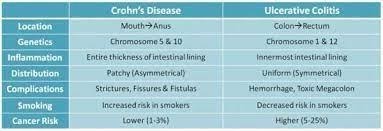A client who is having gastrointestinal (GI) difficulties is undergoing diagnostic procedures.
The client asks the nurse about the difference between ulcerative colitis and Crohn's disease.
Which information should the nurse offer?
Anal abscess and fistula rarely occur in Crohn's disease.
Rectal bleeding is a predominant symptom in ulcerative colitis.
Constipation is more common in Crohn's disease.
Colitis and Crohn's disease don't involve chronic inflammation of the gastrointestinal tract
The Correct Answer is B
A) Incorrect- Anal abscesses and fistulas are more commonly associated with Crohn's disease than with ulcerative colitis. Crohn's disease can involve the entire thickness of the bowel wall and create tunnels or connections (fistulas) between different parts of the gastrointestinal tract.
B) Correct- Rectal bleeding is a common symptom of ulcerative colitis, as the inflamed tissue can bleed easily.
C) Incorrect- Constipation is not a common characteristic of Crohn's disease. In fact, both ulcerative colitis and Crohn's disease can lead to a range of bowel habits, including diarrhea and constipation, depending on the extent and location of inflammation.
D) Incorrect- Both ulcerative colitis and Crohn's disease are inflammatory bowel diseases (IBD) that involve chronic inflammation of the gastrointestinal tract. Ulcerative colitis primarily affects the colon and rectum, causing continuous areas of inflammation and ulceration. Crohn's disease can affect any part of the gastrointestinal tract, from the mouth to the anus. It often involves patches of inflammation with healthy tissue in between, and it can affect different layers of the bowel wall.

Nursing Test Bank
Naxlex Comprehensive Predictor Exams
Related Questions
Correct Answer is C
Explanation
Regular exercise is a vital component of managing type 2 diabetes. It helps to lower blood glucose levels, improve insulin sensitivity, and increase HDL (the "good" cholesterol) levels. However, it is important for the client to obtain medical approval before starting or modifying an exercise regimen. The healthcare provider can assess the client's overall health status and provide specific recommendations regarding the type, duration, and intensity of exercise suitable for the client's individual needs and any potential limitations.
Limiting calories on days unable to exercise is a valid strategy for managing weight and blood glucose levels; however, it is not specifically related to increasing HDL levels. It is important to maintain a balanced and healthy diet overall.
Monitoring blood glucose levels daily is an important self-care practice for individuals with diabetes, but it is not specifically focused on increasing HDL levels. Blood glucose monitoring helps to assess the effectiveness of diabetes management and make necessary adjustments to medication, diet, or exercise.
Monthly appointments with the dietitian can be beneficial for diabetes management, as dietary modifications play a significant role. However, the instruction regarding exercise is more directly related to increasing HDL levels, and the frequency of appointments with the dietitian may vary based on individual needs and goals.
Correct Answer is D
Explanation
A) This can be done if initial non-pharmacological interventions do not relieve symptoms, but it is not the first step.
B) Monitoring blood pressure is important, but it is secondary to removing the stimulus causing the dysreflexia.
C) Incorrect- While education is important for long-term management, the client is currently experiencing symptoms that need immediate attention. The priority is to assess and address the current symptoms.
D) The client is likely experiencing autonomic dysreflexia, characterized by a sudden and severe increase in blood pressure, flushing, headache, and other symptoms triggered by a noxious stimulus below the level of injury. The first step in managing autonomic dysreflexia is to identify and eliminate the triggering stimulus. For clients with a Foley catheter, a common cause of autonomic dysreflexia is bladder distention due to a kinked or obstructed catheter. Relieving any kinks or obstructions in the Foley tubing can immediately alleviate the symptoms.
Whether you are a student looking to ace your exams or a practicing nurse seeking to enhance your expertise , our nursing education contents will empower you with the confidence and competence to make a difference in the lives of patients and become a respected leader in the healthcare field.
Visit Naxlex, invest in your future and unlock endless possibilities with our unparalleled nursing education contents today
Report Wrong Answer on the Current Question
Do you disagree with the answer? If yes, what is your expected answer? Explain.
Kindly be descriptive with the issue you are facing.
